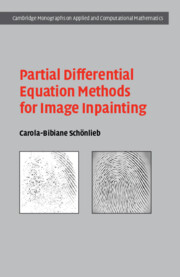Book contents
- Frontmatter
- Dedication
- Contents
- Preface
- 1 Introduction
- 2 Overview of Mathematical Inpainting Methods
- 3 The Principle of Good Continuation
- 4 Second-Order Diffusion Equations for Inpainting
- 5 Higher-Order PDE Inpainting
- 6 Transport Inpainting
- 7 The Mumford-Shah Image Model for Inpainting
- 8 Inpainting Mechanisms of Transport and Diffusion
- 9 Applications
- Appendix A Exercises
- Appendix B Mathematical Preliminaries
- Appendix C MATLAB Implementation
- Appendix D Image Credits
- Glossaries
- References
- Index
4 - Second-Order Diffusion Equations for Inpainting
Published online by Cambridge University Press: 05 November 2015
- Frontmatter
- Dedication
- Contents
- Preface
- 1 Introduction
- 2 Overview of Mathematical Inpainting Methods
- 3 The Principle of Good Continuation
- 4 Second-Order Diffusion Equations for Inpainting
- 5 Higher-Order PDE Inpainting
- 6 Transport Inpainting
- 7 The Mumford-Shah Image Model for Inpainting
- 8 Inpainting Mechanisms of Transport and Diffusion
- 9 Applications
- Appendix A Exercises
- Appendix B Mathematical Preliminaries
- Appendix C MATLAB Implementation
- Appendix D Image Credits
- Glossaries
- References
- Index
Summary
Before we start, let us emphasise here once more that in this and most subsequent chapters we focus on local structural inpainting methods. Structural image inpainting means that we fill in missing parts in images by using local structural information only. To do so, we formulate a partial differential equation (PDE) or a variational approach that picks up this information in terms of colour/grey values and image edges and propagates the information into the missing domain by means of transport and diffusion.
In this chapter we commence our presentation of variational and PDE methods for image inpainting with an axiomatic derivation of a PDE interpolator proposed by [CMS98a]. The resulting generic second-order PDE gives rise to our first three PDE inpainters: harmonic inpainting, total variation (TV) inpainting and absolutely minimising Lipschitz extensions (AMLE) inpainting. In the last section we focus on an extension of TV inpainting that leads us to the discussion of higher-order, in particular, curvature-based, PDEs for image inpainting in Chapter 5.
Throughout this chapter we use the following definitions and assumptions:
• The image domain Ω ⊂ ℝ2 is bounded and open with Lipschitz boundary ∂Ω.
• The inpainting domain D⊂ Ω lies in the interior of Ω, that is, ∂D∩∂=ø.
An Axiomatic Approach to Image Inpainting
One of the most pioneering contributions in PDE-based image processing methods certainly is the work of Alvarez et al. [AGLM93]. There the authors derive a general second-order PDE whose evolution describes a multi-scale analysis of an image, that is, a family of transforms which when applied to a given image produces a sequences of new images.
- Type
- Chapter
- Information
- Publisher: Cambridge University PressPrint publication year: 2015

